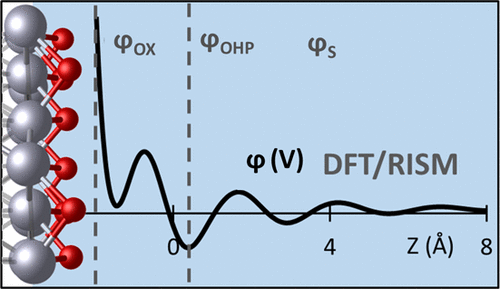当前位置:
X-MOL 学术
›
ACS Appl. Mater. Interfaces
›
论文详情
Our official English website, www.x-mol.net, welcomes your feedback! (Note: you will need to create a separate account there.)
Interface Properties of the Partially Oxidized Pt(111) Surface Using Hybrid DFT–Solvation Models
ACS Applied Materials & Interfaces ( IF 9.5 ) Pub Date : 2019-11-07 , DOI: 10.1021/acsami.9b16326 Victor M. Fernandez-Alvarez 1 , Michael H. Eikerling 1, 2
ACS Applied Materials & Interfaces ( IF 9.5 ) Pub Date : 2019-11-07 , DOI: 10.1021/acsami.9b16326 Victor M. Fernandez-Alvarez 1 , Michael H. Eikerling 1, 2
Affiliation

|
This article reports a theoretical–computational effort to model the interface between an oxidized platinum surface and aqueous electrolyte. It strives to account for the impact of the electrode potential, formation of surface-bound oxygen species, orientational ordering of near-surface solvent molecules, and metal surface charging on the potential profile along the normal direction. The computational scheme is based on the DFT/ESM-RISM method to simulate the charged Pt(111) surface with varying number of oxygen adatoms in acidic solution. This hybrid solvation method is known to qualitatively reproduce bulk metal properties like the work function. However, the presented calculations reveal that vital interface properties such as the electrostatic potential at the outer Helmholtz plane are highly sensitive to the position of the metal surface slab relative to the DFT-RISM boundary region. Shifting the relative position of the slab also affects the free energy of the system. It follows that there is an optimal distance for the first solvent layer within the ESM-RISM framework, which could be found by optimizing the position of the frozen Pt(111) slab. As it stands, manual sampling of the position of the slab is impractical and betrays the self-consistency of the method. Based on this understanding, we propose the implementation of a free energy optimization scheme of the relative position of the slab in the DFT-RISM boundary region. This optimization scheme could considerably increase the applicability of the hybrid method.
中文翻译:

使用混合DFT-溶剂化模型的部分氧化Pt(111)表面的界面性质
本文报道了对氧化的铂表面和水性电解质之间的界面进行建模的理论计算工作。它努力考虑到电极电势,表面结合的氧物种的形成,近表面溶剂分子的定向有序化以及金属表面沿法线方向对表面电势的影响。该计算方案基于DFT / ESM-RISM方法,以模拟在酸性溶液中具有不同数目的氧原子的带电Pt(111)表面。已知这种混合溶剂化方法可以定性地复制诸如功函之类的块状金属特性。然而,提出的计算结果表明,重要的界面特性(如外部亥姆霍兹平面上的静电势)对金属表面平板相对于DFT-RISM边界区域的位置高度敏感。改变平板的相对位置也会影响系统的自由能。因此,ESM-RISM框架内的第一溶剂层存在最佳距离,这可以通过优化冷冻的Pt(111)平板的位置来找到。就目前而言,手动采样板坯位置是不切实际的,并且背叛了该方法的自洽性。基于此理解,我们提出了在DFT-RISM边界区域中平板相对位置的自由能优化方案的实现。
更新日期:2019-11-08
中文翻译:

使用混合DFT-溶剂化模型的部分氧化Pt(111)表面的界面性质
本文报道了对氧化的铂表面和水性电解质之间的界面进行建模的理论计算工作。它努力考虑到电极电势,表面结合的氧物种的形成,近表面溶剂分子的定向有序化以及金属表面沿法线方向对表面电势的影响。该计算方案基于DFT / ESM-RISM方法,以模拟在酸性溶液中具有不同数目的氧原子的带电Pt(111)表面。已知这种混合溶剂化方法可以定性地复制诸如功函之类的块状金属特性。然而,提出的计算结果表明,重要的界面特性(如外部亥姆霍兹平面上的静电势)对金属表面平板相对于DFT-RISM边界区域的位置高度敏感。改变平板的相对位置也会影响系统的自由能。因此,ESM-RISM框架内的第一溶剂层存在最佳距离,这可以通过优化冷冻的Pt(111)平板的位置来找到。就目前而言,手动采样板坯位置是不切实际的,并且背叛了该方法的自洽性。基于此理解,我们提出了在DFT-RISM边界区域中平板相对位置的自由能优化方案的实现。


































 京公网安备 11010802027423号
京公网安备 11010802027423号